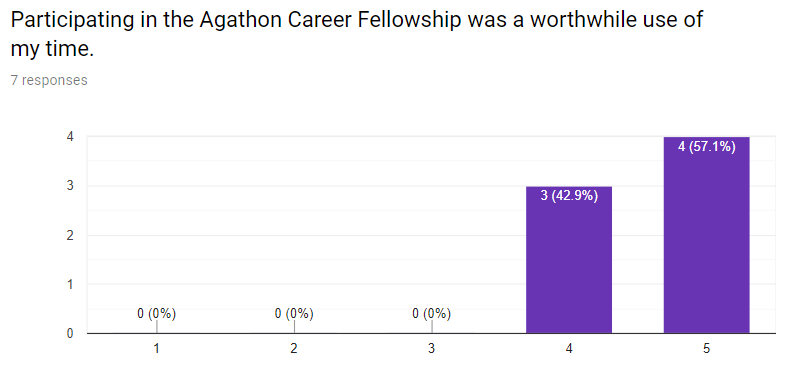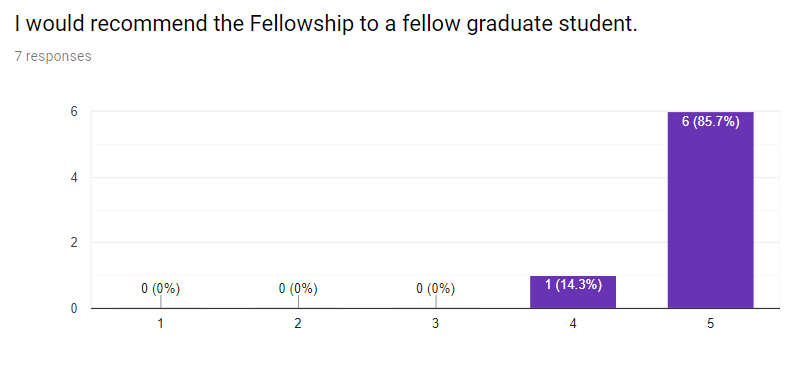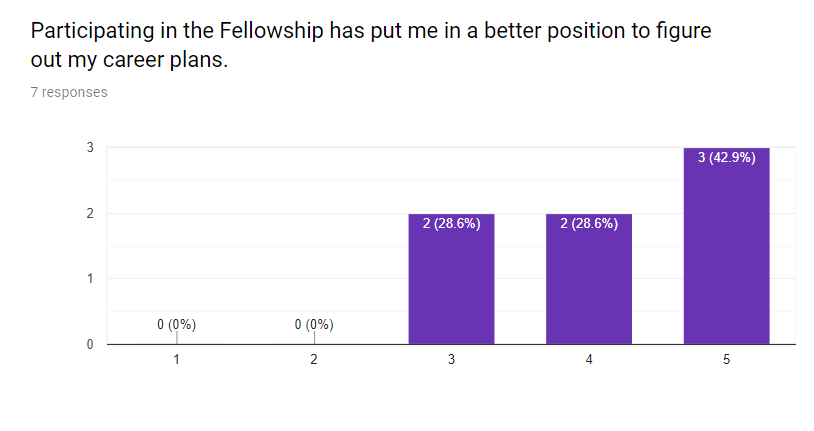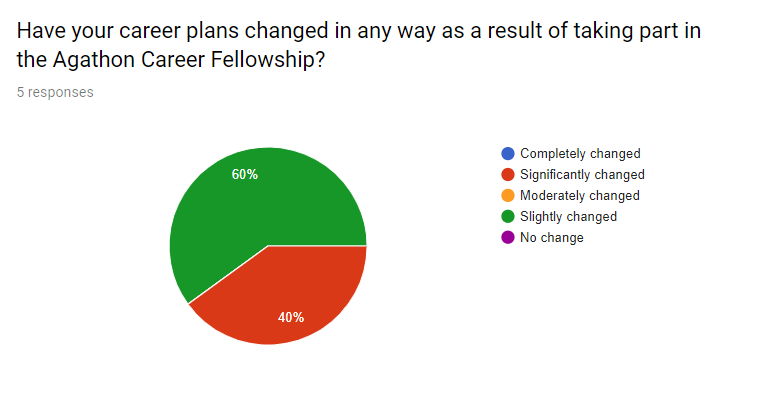In Fall 2018, EA at Harvard ran its very first career planning-focused fellowship, the Agathon Career Fellowship (hereafter, ACF). This is a report of what we did, what resulted, and what we would do differently. It's hopefully also a guide for any other groups that want to run career fellowships. Our materials are linked within.
Team
ACF was the first major effort of the newly formed Harvard Graduate School of Arts and Science Effective Altruism (elegantly shortened to HGSASEA), led by Chris Bakerlee, Elliot Glazer, and Holly Elmore (me). The entire program was a team effort, but Chris is the lead author of the curriculum.
Branding
At Harvard, the term "fellowship" is used very broadly and only implies an application process and multiple mandatory meetings, but the EA organizers use it as often as possible because "fellowship" makes a more attractive resume line for the fellows than "club" or "reading group." Following the cue of the undergraduate group (HCEA), who dubbed their Intro to EA fellowship the "Arete Fellowship," Chris chose the name "Agathon Career Fellowship" following the use of Agathon in Plato's Republic to mean, essentially, "the highest good." This gives the fellowship the ring of something endowed, making it seem more established and serious. It also looks that way on resumes.
Advertising
We advertised via posters on campus (which previous informal research by HGSASEA had determined to be surprisingly effective), targeting buildings frequented by grad students, and mass emailing of the grad student section of EA at Harvard's mailing list on MailChimp. The application deadline was 10/5/18, and essentially identical emails were sent on 9/20/18, 9/27/18, and 10/5/18, the night of the deadline. Ideally, the advertising and the application all would have taken place earlier in the semester so that no one was excluded because of unnecessary scheduling conflicts and to take advantage of early-in-the-semester optimism about how much one can do. Now that the curriculum is developed, we have the option of launching earlier in future semesters.

At all steps of advertising, we projected a very official image: having an application, having firm deadlines, and requiring that applicants be able to attend every session.
Tone
Chris has a background in consulting, and was very helpful in striking a balance between formal and comfortable. Formality was highest during the advertising and application phase, somewhat reduced during session 1 with our fellows, and gradually relaxed over the rest of the sessions.
In my opinion, and based somewhat on our feedback, this early formality put our applicants and fellows at ease, assuring them that this program was well thought out and a good use of their time. Particularly for a career fellowship, I believe it is important that the organizers project competence and leadership ability. At the same time, it's important not to pretend to be experts on career choice, and to make clear when we don't know something or when 80,000 Hours doesn't have the final word. Overall, I would say we were more formal than most "formal" EA events I've been a part of, but not by too much.
Applications
Here's the text from the google form we used for the application. It's a very short and simple application, based on what we thought actually mattered in an applicant-- that they were in a position to benefit from our help and that they were willing to open their minds and think critically about beliefs that were important to them. There are only four questions that aren't just asking for biographical information:
1. Why are you applying to this fellowship program? How do you hope it will affect your career?
2. What are your biggest uncertainties about your career?
3. What is an issue on which you have a strong opinion? Briefly state your opinion.
4. Take the issue from the last question and state an opposing view. Then explain the logic of the opposing view But as if you were posing as someone who held that opinion.
The last two are an Ideological Turing Test.
We received 44 applications, which we evaluated all at once together. In our first pass, Chris, Elliot, and I gave our definite NOs and definite YESs. Once we agreed definite YESs and definite NOs between us, we filled in the rest of the cohort from the MAYBE pile. Our main criterion in selecting MAYBEs was to balance out the cohort as far as school, field, masters vs. PhD, where they were in their programs, etc. in the hopes of making the program as enriching as possible for the participants.
Curriculum
The Agathon Career Fellowship followed this curriculum designed primarily by Chris Bakerlee with input from me (Holly Elmore) and Elliot Glazer. (Powerpoints from our lectures are available upon request.)
The fellowship took place in four group meetings over four consecutive Mondays followed by one-on-ones between the organizers and the fellows in the following two weeks. Meetings included some icebreakers, which were largely effective (such as getting to know the person next to by making up a secret handshake, introducing them to the rest of the group and performing your handshake). The meetings were a blend of discussion and lecture, aiming for as much discussion as possible.
As you can see in the linked curriculum outline, for the first three sessions, we essentially walked through 80k career guide. The concepts of Importance-Neglectedness-Tractability framework, career capital, and A/B/Z planning in particular were well-received. The 4th session was peer career coaching. The fellows gathered in groups of 3 and spent 20 minutes focusing on each person. This was very well-received and I personally witnessed a lot of creative thinking unleashed by these new perspectives and peer support.
Pedagogy
We approached the ACF as a forum where we presented tools and frameworks from an EA, impact-oriented perspective that can help you make better decisions and a greater impact, no matter what line of work you choose to pursue. We emphasized that, for example, you can use I-N-T framework when deciding which problems to work on in your specific academic subfield, or you can use the idea of flexible career capital to position yourself for a future career transition.
The first rule of our teaching style was epistemic humility. That meant lots of listening and even more “I don’t knows.” To maximize fellow engagement, we attempted to make lectures as interactive and discussion-based as possible. We were these people’s peers, and we wanted it to be clear that, although we thought we had some compelling information for them, we are all just trying to figure out the complicated question of how to do good and lead a good life.
Personalized Coaching
Each fellow was given the opportunity to have one-on-one coaching with me, Chris, or Elliot in ~30 minute sessions. We are no experts, but we hoped to give them a little more guidance than the Career Guide or their peers could. Our strategy was to help them think in terms of impact, to think flexibly, and to connect them to people in EA and at Harvard that could answer more concrete questions for them about fields or jobs they were considering.
Funding and Costs
We received $800 in funding from CEA, which amounted to $200 per meeting. This was sufficient to feed everyone a nice vegan dinner, our only expense.
Strengths and Weaknesses Compared to Other Kinds of Programming
Strengths:
- Easier to plan ahead
- Get to know and spend substantial time with fellows
- Does not require scheduling around professors or guest speakers
- Advertising is one-time push and not a constant necessity
- Get to advanced topics and deep engagement
- Highly repeatable
- After the initial curriculum development, lesson plans can be reused and refined with much less effort
Weaknesses:
- Requires several fully committed volunteers
- Volunteers must be very familiar with EA career choice literature, at risk of delivering counter-productive messages
- Volunteers must be well-connected enough within EA or within a general domain of careers covered by the fellowship to offer fellows effective leads
- Not reaching as many people as a large general audience talk
Minor Mistakes
-Ideally, the advertising and the application all would have taken place earlier in the semester so that no one was excluded because of unnecessary scheduling conflicts and to take advantage of early-in-the-semester optimism about how much one can do. Now that the curriculum is developed, we have the option of launching earlier in future semesters.
-Giving charismatic examples of careers that had a large impact, such as Norman Borlaug’s, made some in the group think we were promoting the Great Man theory of history. It took a lot of discussion to unpack. The point is not that Norman Borlaug was a great man, but that having better wheat varieties at that time in history saved many lives. It would have been just as good if the wheat varieties were developed by a consortium of thousands of scientists-- just not as good of a career choice anecdote. Try to make it clear that we are looking at these examples because they illustrate a single career where an individual made a big counterfactual difference,not because this working solo is the best or even a desirable way to try to improve the world.
Major Mistakes
Advertising as though we just wanted to help people find the right careers for them, but pretty quickly pivoting to how to do the most good and priority paths. We took our cue from the Career Guide-- the crux is that doing good for others is what makes people happy. This all made sense to the three of us when we read the guide and designed the curriculum, but when it came to teaching it, it just came off as a convenient assertion. I felt like I was selling a bill of goods. Because we had promised that we would put the priorities of the individuals first in giving career advice, that's what we did, and the Career Guide became an awkward presence for me a lot of the time.
If I ever put on ACF again, I'm planning to advertise it as a fellowship to find a career that does a lot of good. It just feels dishonest to pretend 80,000 Hours's material is about personal satisfaction. There just isn't enough there for people who aren't willing or able to take a priority path.
The limitations of the 80,000 Hours recommendations for most people. Our fellows were graduate students, but already they had significantly more history and attachments that made it difficult for them to follow "priority" paths if they wanted to than the undergrads the Career Guide is written for. One solution would be to focus on those people whom the guide already applied to (before it was deprecated), and from what I understand, that was 80,000 Hours's approach.
My philosophy for running student or local groups is that they should serve the members and build a sense of community, which is usually the biggest end in itself. I don't think that targeted recruitment of promising people for priority paths fits that bill. I want to continue to develop a curriculum and an application process that brings us a wide net of people but doesn't take us too far outside of the research and principles that 80,000 Hours has developed.
Fellows came in at too many different levels of familiarity with EA. We were trying to cast a wide net, and we caught a wide catch! Our cohort was very diverse in school, program, background, place in grad school, etc. But one thing we should have filtered for was familiarity with EA. We had one fellow leave after the first meeting because he found the information too rudimentary. Others were still playing catch-up with EA concepts at the final meeting, while still others seemed not to absorb much of EA at all. One person expressed this view in the exit survey: “My main suggestion would be to either select for people with some baseline familiarity with 80,000 Hours OR to make clear in the promotion of the program that it is designed for people who aren't already familiar with the framework. Also creating a bit more transparency about the schools/programs that participants were being selected from; some people seemed to be under the impression that everyone was in a Doctoral program, which made me feel a little self-conscious as a Masters student.”
Impact
Exit survey
The 7/15 fellows who responded to our exit survey rated the Fellowship highly overall.



In the short answer section, it was generally agreed that the company and the connections were the most valuable part of the series, though the tools and reading resources were also highly valued. There were some complaints that there was too much lecturing, especially by those who had prior familiarity with 80,000 Hours.
9-month followup
With 5/15 responding:

It appears one person decided to leave academia because of the fellowship: “Basically, during the fellowship I realised I won't regret finishing my PhD and not having a job in academia. I've been actively looking into other activities and fields that would make me achieve my future goals. I'm happy I had the chance to discover the Agathon Career Fellowship!”
We helped to tip another person into the higher impact direction they were already leaning, and they have a position in their new field: “I was a little unsure whether I should continue in my old line of work (financial regulation) or pursue a new line which I thought would be greater impact (e.g. improving decision-making, or supporting effective charities/nonprofits). I was already strongly leaning towards the latter but conversations I had as a result of the Agathon Fellowship made me feel more confident about this judgement and as a result I applied to and accepted a job in applying behavioral science to improve government decision-making.”
And some are still in the process of figuring things out: “I still have no idea what I want to do, but I feel recommitted to the idea of creating maximal impact on whatever path I do eventually pursue.”
Community impact
Agathon has also integrated new people into the EA community. As proof, two Spring 2018 Agathon Fellows did high-commitment volunteering at EAGxBoston 2019.

Thanks for writing this! I find that I wind up linking to postmortem assessments like this one quite often when people ask me for advice about their project ideas, and I'd be surprised if I never have cause to share this (as I've shared similar Forum writeups from EAGx Boston, SHIC, etc.)
One question: How did you attempt to get responses for your exit survey? 7/15 is a pretty low rate, and while I see why it's not great to bother people too much once they've finished your program, I'd be interested whether many of the non-respondents reported "no change".
(I've been at a few EA events where surveys were conducted at the end of the event, everyone filling them out at once, but I don't know whether that was practical for a program like this, where people may have needed time to think afterward in order to answer with confidence.)
iirc, we actually did prompt them to take the exit survey and give them time to fill it out during the fourth meeting, but clearly not everyone did. But my memory of that is really not clear. We had been in breakout groups most of that session so maybe there was too much disorder when we asked them to take a survey at the end of that. And if we had done that then they wouldn't have had their one-on-one meetings with us yet.
For the 9 month follow-up we just sent them an email.